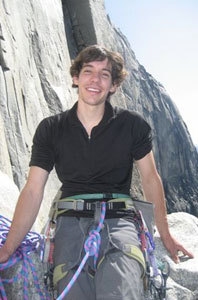Alex Honnold climbing interview

 1 / 5
1 / 5 David Simmonite
David Simmonite
Alex Honnold, the 23 year old Californian who first started climbing eight years ago in a gym in Sacramento, rose to world attention big time in September 2007 with his single day solo ascents of the legendary multi-pitches Astroman and The Rostrum. This feat had been performed only by Honnold's mentor Pete Croft back in 1987 and the youngster's cool performance understandably made waves in the American climbing scene.
In many respects this Yosemite double was a mere warm up for what lay ahead: in April 2008 Honnold took things one step further and soloed the epitome splitter crack testpiece, Moonlight Buttress in Zion, while in September Honnold took things one stage further still, soloing the Regular NW Face on Half Dome. Honnold was obviously a name to to look out for.
At the end of 2008 Honnold's nerve was put to the test on a trip to England with fellow climbers Kevin Jorgesson and Matt Segal. Between one rain shower and the next he made extremely impressive ascents of some of the hardest of gritstone testpieces in the country: The Parthian Shot, New Statesman and Gaia were just three of his grand prizes, climbed with extreme precision and boldness. We decided to find out more.
Alex Honnold interview
Alex, you were brought to world attention by freesolos of Astroman (5.11c) and the Rostrum (5.11c) in Yosemite in a single a day in 2007. Tell us about the difficulties you encountered?
For me the hardest part about Astroman and the Rostrum was actually getting off the ground. Getting over the initial mental hurdles against soloing something so big and sustained. They were the first times I'd ever done anything like that. None of those routes are super hard climbing by sport climbing standards. The hardest part is definitely getting the confidence and the psyche to solo them.
You then upped the ante by soloing Moonlight Buttress, one of the great outings at Zion.
I'd flashed Moonlight a few years before and I'd had a great time. I liked the route and knew I could do it. I just got it in my head that I wanted to solo it so I made it happen. The route might be a little easier than 5.12d, but that doesn't really matter in the grand scheme of things. If you're going to solo a route like that the grade is the least of your worries. My lasting memory of my climb is jamming the last few pitches. The buttress narrows down, it feels more exposed and you have all four points jamming a splitter finger crack. It's an amazing, amazing feeling.
You worked the route, using static line and a mini-traxion 4 times prior to the ascent. Do you think this took anything away from your solo?
It certainly didn't take anything away from it for me! I wanted to solo Moonlight, the only way I would do it was if I felt confident on it. So I practiced until I felt good and then soloed it. It felt good to know exactly what to do and do everything perfectly. I've never really explored my onsight soloing limits - and I'm not totally sure I want to. I have a ton of respect for people who onsight solo at a high level, and I might push myself in that way in the future. But honestly, I don't really want to kill myself. It'd suck to fall...
Yet in September 2008 you soloed the Regular NW Face on Half Dome, a 1500 ft route with a 5.12a boulder and a fair amount of super insecure 11+.
Half Dome is a super impressive piece of rock. Even the hike up is sort of intimidating. I hadn't rehearsed it as much as Moonlight and it was definitely more challenging. The nature of the climbing is just harder: technical, insecure granite, slabs, even the cracks aren't straightforward jamming. Having said that, I'd describe it as super fun climbing on an amazing wall. It's the solo I'm most proud of.
What goes through your mind when free soloing?
On harder routes I'm generally all tuned out. "In the zone" or whatever people want to call it. Very focused but not really thinking about anything. On easier routes I'm generally just having a good time. I carry on conversations and listen to music and whatever else. I've answered my cell phone. It just depends on how hard the climbing is.
Do you consider yourself predominantly a solo climber or is this an incomplete picture?
Definitely an incomplete picture. I spend most of my time doing things on a rope, be it trad or sport. I'm just not very good at it so no one ever hears about it. But I really only solo a few things a year.
Recently though you were in the international limelight with your extremely successful climbing trip in England together with Kevin Jorgesson and Matt Segal. Not many American climbers visit the UK, especially in November!
I know it's not a normal season for climbers over there but Kevin and Matt put the trip together and I got free airfare, courtesy of The North Face, so I wasn't about to pass up the opportunity. And as it turns out we got in enough climbing and everything worked out well. It's better to go somewhere new during bad weather than to just not go!
What idea did you get of British gritstone?
The gritstone game could be described as a crazy combination of highball bouldering and sporty (meaning both athletic like a sport route and run out) trad climbs. Basically though it's just a cool style of climbing on uniquely good rock.
Your list of ascents dodging the raindrops is impressive to say the least. What would you consider your most important achievement there and why?
I think "important achievement" might be overstating the impact of a climbing trip. Curing AIDS is an "important achievement". We just climbed a lot and watched movies in the rain. I guess though the things I'm most proud of are "onsighting" Gaia and Master's Edge. Having said that, my onsight solo of London Wall might be my personal favourite. I'd thought about this for quite a while.
You meticulously specified your style of ascent of Gaia...
I'd seen Hard Grit a few times as well as Dosage when Lisa Rands does Gaia. But I never remember that kind of stuff. I guess technically it is a flash, but in my little notebook where I record my routes and stuff it's an onsight. That's good enough for me.
For us too therefore! So tell us about your experiences on Gaia and Masters Edge.
My experiences on these two routes were completely different. Gaia had no chalk on it but isn't physically very hard during the runout. I just had to stay calm and move slowly and it wasn't so bad. Masters Edge on the other hand was all ticked up (we found it that way, lucky break!) and super chalky so it was just like doing a sport route. But physically it was pretty sustained and I found the climbing up to the gear to be hard. It was scary being so high above my pad. To be honest, I'm not much of a boulderer.
Both these routes date back to the '80's...
The fact that Johnny Dawes and Ron Fawcett put all that stuff up in the '80s is super impressive. I found the John Dunne routes even more impressive though just because they seemed physically harder. But either way it's cool that those guys were putting up such hard routes in good style so long ago.
Will you be back?
On my last climbing day in England I went out and soloed Gaia. It was a beautiful way to end the trip: a clear blue day and the route was glowing in the sun. Perfect. Yes, I could see myself returning some day to climb on the other types of rock. Maybe sea cliffs or the slate. It seems like there's a lot of unique climbing there. But first I want to sport climb in Europe. I've heard there is better weather in Spain...
You recently returned to Yosemite once again. What does the valley represent to you?
Well the Valley is close to home so I'll always come back. But it also has the most awe inspiring walls I've ever see. Bear in mind I haven't travelled that much, but they really are super impressive... And you can't beat the weather in California: you can climb walls in sunshine year round. The weather is amazing.
Who would you consider your climbing forerunners?
I've always been inspired by Peter Croft and John Bachar, I've heard stories about them from the Valley for years. Now though I think I'm more inspired by Tommy Caldwell. It's amazing how he's taking the difficulty of sport climbing and bouldering and applying it to big walls.
Big walls, sport climbing, short desperates. Which direction is your climbing heading in?
I don't know if I have a set direction, but I'm definitely more inspired by big walls. Who knows? Time will tell.
Alex Honnold on Gaia E8 6c, Black Rocks, England
| Links Planetmountain | |
| News Honnold | |
| Links Expo.Planetmountain | |
| Expo Black Diamond | |
| Links www | |
| www.davidsimmonite.com | |



 Copia link
Copia link

























